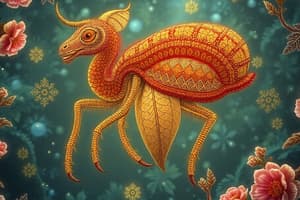Podcast
Questions and Answers
What are the three broad categories that mating behaviors can be classified into?
What are the three broad categories that mating behaviors can be classified into?
- Courtship, copulation, post-copulatory behaviors (correct)
- Male prowess, female selection, sperm competition
- Courtship, mating, post-copulatory behaviors
- Visual displays, vocalizations, scent marking
Which behavior helps individuals find a suitable mate and facilitate mating?
Which behavior helps individuals find a suitable mate and facilitate mating?
- Cryptic female choice
- Copulation
- Visual displays (correct)
- Sperm competition
During which process does the male's sperm fertilize the female's egg?
During which process does the male's sperm fertilize the female's egg?
- Post-copulatory behaviors
- Cryptic female choice
- Copulation (correct)
- Sperm competition
What is the term for behaviors that occur after copulation and can affect fertilization outcome?
What is the term for behaviors that occur after copulation and can affect fertilization outcome?
Which of the following is NOT a category of mating behaviors?
Which of the following is NOT a category of mating behaviors?
What kind of behaviors are pre-copulatory and help individuals find a suitable mate?
What kind of behaviors are pre-copulatory and help individuals find a suitable mate?
Where are gametes (sperm in males and eggs in females) produced in males and females respectively?
Where are gametes (sperm in males and eggs in females) produced in males and females respectively?
What is fertilization?
What is fertilization?
Which process leads to genetic variation within a population?
Which process leads to genetic variation within a population?
What is the purpose of mating behaviors in animals?
What is the purpose of mating behaviors in animals?
In which type of fertilization is there physical contact between the male and female?
In which type of fertilization is there physical contact between the male and female?
What is the role of gonads in the reproduction process?
What is the role of gonads in the reproduction process?
Flashcards are hidden until you start studying
Study Notes
Reproduction in Animals
Reproduction in the animal kingdom is a fascinating and essential process that ensures the continuation of species. As we delve into this topic, we'll explore the key components of reproduction, including reproductive organs, fertilization, sexual reproduction, and mating behaviors.
Reproductive Organs
Reproductive organs, or gonads, are specialized structures that produce gametes (sperm in males and eggs in females). In males, gametes are produced in testes, while in females, gametes are produced in ovaries. In some species, like some reptiles and fish, gonads are not segregated into separate organs as they are in mammals and birds.
Fertilization
Fertilization is the fusion of male and female gametes, resulting in the formation of a zygote, the first cell of a new individual. Fertilization can occur internally (as in mammals) or externally (as in most fish and amphibians). In internal fertilization, the male's sperm travels through the female's reproductive tract to reach and fertilize the female's egg. In external fertilization, sperm and eggs are released into the surrounding water, and fertilization occurs without any physical contact between the male and female.
Sexual Reproduction
Sexual reproduction is the process by which two genetically distinct individuals produce offspring. This process results in genetic variation within a population, which is crucial for adaptation and survival in a changing environment. Sexual reproduction is a common strategy for animals, although certain species, like some plants and asexual animals, reproduce asexually, without the involvement of gametes.
Mating Behaviors
Mating behaviors vary widely among species and are shaped by factors such as the physical environment, social structure, and natural selection. These behaviors can be broadly classified into three categories: courtship, copulation, and post-copulatory behaviors.
-
Courtship: Courtship behaviors are pre-copulatory behaviors that help individuals find a suitable mate and facilitate mating. These behaviors can include visual displays, vocalizations, scent marking, and elaborate dances or displays of physical prowess.
-
Copulation: Copulation is the physical act of mating, during which the male's sperm fertilizes the female's egg. The duration and nature of copulation are highly variable among species and can range from brief and simple to lengthy and complex rituals involving multiple partners.
-
Post-copulatory behaviors: Post-copulatory behaviors are behaviors that occur after copulation and can affect the outcome of fertilization. These behaviors include sperm competition, in which a male's sperm competes with sperm from other males for fertilization of the female's eggs, and cryptic female choice, in which females choose mates based on hidden traits such as genetic compatibility.
Reproduction in animals is a complex and fascinating process that ensures the continuation of species and provides incredible examples of adaptation and evolution. As we continue to explore this topic, we can better understand the factors that shape reproduction and the diverse strategies animals have evolved to ensure their survival and success.
Studying That Suits You
Use AI to generate personalized quizzes and flashcards to suit your learning preferences.




